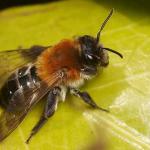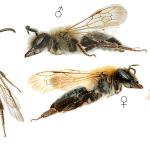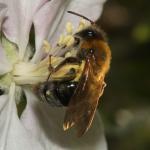Andrena pubescens OLIVIER 1789; Andrena consimilis SMITH,F 1847
There has been considerable confusion over the correct name to apply to this distinctive spring flying species, A. nitida or A. pubescens. It is a large Andrena with, when fresh, bright, foxy-brown hair on the thorax and a polished black abdomen. Females have thin apical side-bars of white pubescence on abdominal segments 1-3, and males have copious white facial hair, especially on the clypeus.
This species is commonly found throughout southern Britain, becoming scarcer towards southern Yorkshire, its most northerly known county. There is some doubt about the correctness of Irish records (Stelfox, 1927) and those from Scotland. It is widespread and common in Europe, also being known from Iran.
This bee is not regarded as being scarce or threatened.
May be found in a variety of open grassland habitats.
Univoltine: April to June
This species nests among short to medium-length grassland; there is no obvious preference for areas of bare ground. Nests are always well-dispersed.
There are no strong preferences in the flowers visited, both males and females can be found quite high up on blackthorn (Prunus spinosa) and down low on dandelions (Taraxacum officinale).
It is possible that the cuckoo-bee Nomada goodeniana parasitises this species. It is known to be parasitised by the Strepsipteran Stylops melittae, but this is not very frequent.
2006




